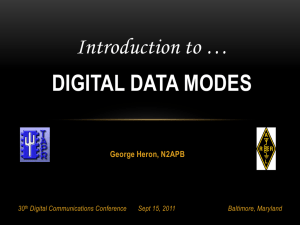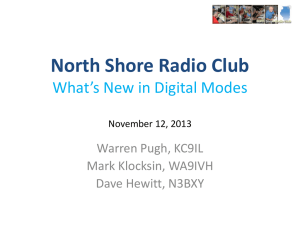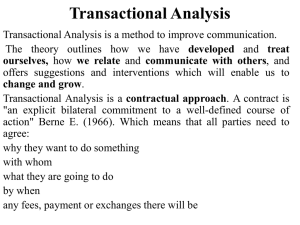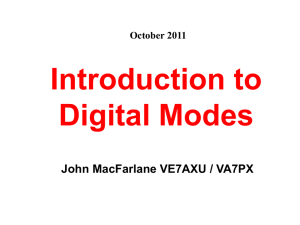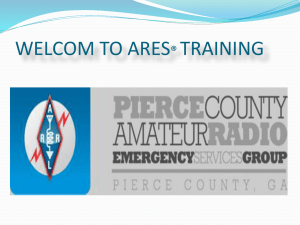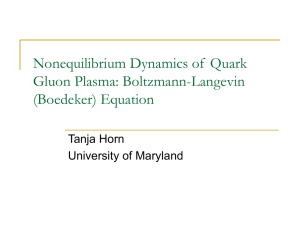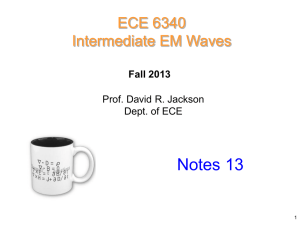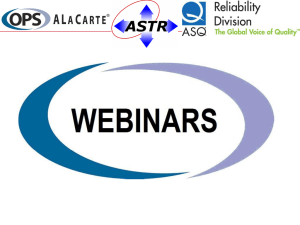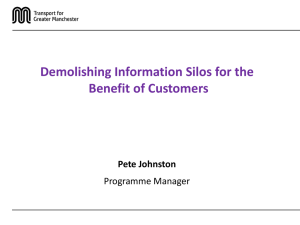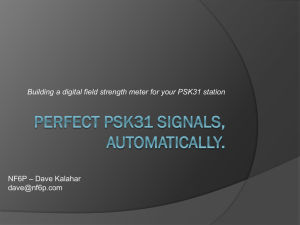Digital HF - Gloucester County Amateur Radio Club
advertisement
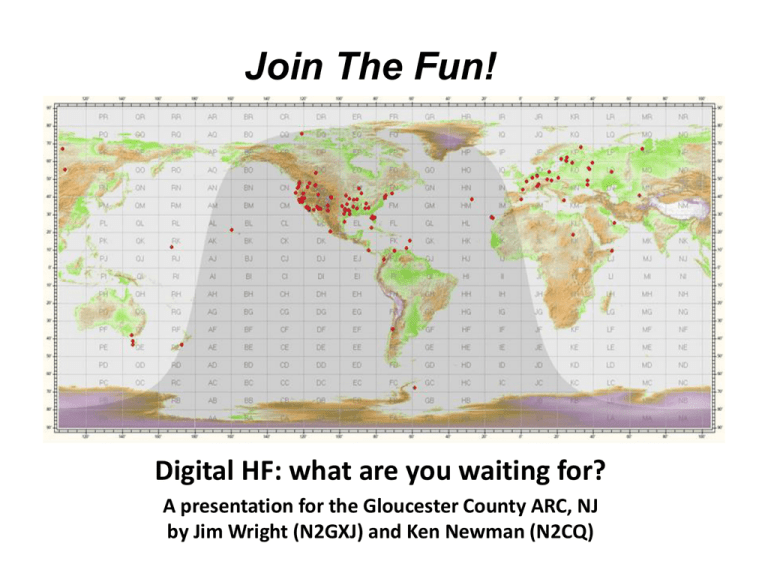
Join The Fun! Digital HF: what are you waiting for? A presentation for the Gloucester County ARC, NJ by Jim Wright (N2GXJ) and Ken Newman (N2CQ) Why add digital modes? • Be honest – Tired of your old radio? – Too much static in the headset? – Frustrated with band conditions? – Tired of the same old operators? – Want to meet some new hams? – Want to enjoy more DX? Then maybe the HF digital modes are for you! 2 HF digital modes To quote long time ham, NB6Z “The distinguishing features of live HF digital operation today are the use of lower power, compact or indoor antennas, and courteous operating technique. This reverses the trend of several years ago…” Unexpected operating benefits • When operating radio in digital mode, there’s no microphone, no noisy speakers, no headset required! • Break free of the shack! With a laptop, can enjoy quiet time with your significant other, sitting together on the couch (pretending) to watch your (their) favorite (reality) TV show, while still chasing DX! (… Just saying… Not that anyone would do this... Would they?) 3 Band conditions • “Conditions are terrible. The bands must be closed.” – Not so fast! – It used to be that you had to “hear ‘em to work ‘em” – Not so with some of the modern digital modes! To put it in perspective, a 2002 study found majority of CW ops could copy at an S/N ratio of 0db, but less than 4% could copy down to -7db*. Contrast that with digital mode ‘Olivia’ which can be decoded when it is 10-14 db below the noise floor (noise is 3x stronger than the signal!) And digital mode ‘JT65HF’, with QSOs possible to -20db! *ref: “The Weak-Signal Capability of the Human Ear”, Ray Soifer, W2RS, Proceedings of the Central States VHF Society Conference, 2002 – Low sunspots, spectrum crowding, fading, impulse noise, static crashes, QRM, QRN, QSB, you name it: • Modern digital modes are popular because they can work well, even under less than ideal conditions! Bands seem dead? Try HF digital modes instead! 4 Enjoy more DX! • “It’s hopeless. I’ll never get DXCC.” – Wrong! We’re lucky living on east coast USA! – You just need to try HF digital modes, they’re DX friendly! (See the 4 hour reception map on the title page of this presentation) – It’s not uncommon to log more than a dozen countries in a single hour with one mode (PSK31) on one frequency (14.070 Mhz). – Worked All States (WAS) and mixed mode DX Century Club (DXCC) awards in less than a year with under 50W and only a dipole antenna up in the attic? Yes, you can! (e.g. n2gxj) – If you’re an SSB and/or CW op, for fun, why not consider adding digital modes to your existing DX options? Digital modes are DX friendly! 5 Meet new hams! There’s a growing community of new digital users out there all over the globe, on all bands, at all hours of the day! Digital is the fastest growing area of our growing ham radio hobby! *ref2 *ref1: http://pskreporter.info/pskmap.html 4/21/2012 *ref2: “Ham Radio for Dummies”, W.Silver, Wiley&Sons pub 6 Enjoy more DX! East coast stations regularly catch digital DX *ref: http://pskreporter.info/cgi-bin/pskstats.pl 4/17/2012 7 Enjoy more DX! *ref: http://pskreporter.info/cgi-bin/pskstats.pl 4/17/2012 Maybe add digital modes to your existing DX capabilities? 8 A typical Saturday afternoon How many digital QSO can you count in this 3khz of audio bandwidth? 9 Panoramic simultaneous decode! That looks fun! … Ready to give it a try? 10 Adding digital capabilities • Goals: – Upgrade, not replace, existing HF radio ($) – Preserve your existing CW/SSB capabilities! – Add a whole new world of HF digital possibilities! • How to? The options: – If your radio is an SDR, just add digital software – Else, connect audio jacks/ptt on your radio via an adapter to ports on your PC, then add digital software to your PC • Via “build-it-yourself” interface, or • Via “buy-it-yourself” interface 11 Build or Buy interface Basic elements of either approach: • (RX) Audio from radio into the PC • (TX) Audio from PC to the radio • (TX KEY) PTT, or VOX, for transmit 12 Build-it-yourself *ref: http://www.qsl.net/wm2u/interface.html For the $ saver, DIY enthusiast • • • • For SWL, no circuit needed. Just let computer’s built-in mic listen to the radio For clean RX/TX, use cables and the PC’s sound card for A/D, D/A conversion Simple connection shown above, with VOX enabled on radio for TX, may be all you need If ground loop issues, use audio transformers, as shown on right *ref: http://www.hamradio.cc/projects/psk31/PSK31.pdf If you are thinking of BIY, a recommended reference: http://www.qsl.net/wm2u/interface.html 13 Buy it Yourself • Easy install: *Ref: Pictured units and trademarks are property of their owners: SignaLink (Tigertronics), RIGBlaster (West Mountain Radio), MFJ (MFJ) – Vendor often can supply cables specific for your radio model • Interface simplicity: – USB between Box and your PC (most PC’s don’t have RS232 anymore) • Interface box contains its own soundcard – Soundcard in PC can still be used for PC sound 14 Digital mode software • Hundreds of choices • Some that may have been good in 1999, or even 2007, just can’t compare to the most popular choices in use today • Some features to consider: • • • • • Continued support/upgrades Compatibile with your PC’s OS If it has the modes you want Ease of integration with contesting/logging program(s) Interfaces with online service(s) • • • • Callsign lookup Electronic QSL services Spotting networks Reverse beacon networks • Cost 15 Multimode or specialty? • Start with a multimode software package – – – – Lets you operate many popular modes without switching programs Learn once, use for many modes, higher enjoyment Tend to be more modern, more features, more fun Get familiar with one, then can compare with others, at your leisure • Later can look into specialty programs, e.g. – – – – Weak signal beacons/reception reporting (e.g. WSPR), Weak signal QSOs (e.g. JT65HF), Digital slow scan TV (e.g. EasyPal), Digital modes on smartphones (see cover story of May 2012 QST magazine) 16 Top Picks (imo)(alphabetical) • Fldigi (http://www.w1hkj.com) • Available for Linux, OSX, and Windows. Popular for narrowband messaging, emergency comms use. Free. • HRD/DM780 (http://www.hrdsoftwarellc.com) • Package includes integrated rig control, decoders, logger, and much more. Windows. Pay after June 2012. • MixW (http://mixw.net) • Windows. Favored by many digital contesters. Pay. • Multipsk (http://f6cte.free.fr/index_anglais.htm) • Some consider this the “swiss army knife” of digital software packages. Register (pay) version more full featured. – older (Digipan, Hamscope) – try a few, see what works for you! Ref with links to these, and more: http://www.westmountainradio.com/content.php?page=links 17 Topics for future presentations Many digital software packages integrate with electronic logging systems (like LoTW, eQSL, HRDLOG.net), and online services (such as callsign lookup (e.g. qrz.com), DX clusters, and reverse beacon networks (above: qso’s logged in last hour, hrdlog.net)) Each of these are involved enough to be candidate topics for future discussion! 18 Digimodes • These are the ones to start with: – Radio Teletype (RTTY) Frequency Shift Keying – PSK31 Phase Shift Keying • After those, you might consider adding some of these modes to your digital DX repertoire – – – – – MFSK - if one or two tones are good, why not more? JT65a - just for DX qso credit. No conversations at all. Olivia - conversational, even for very faint signals Hellschreiber – let your eyes do the fax processing SSTV - sending regular and high def pictures over HF • How to recognize these modes, and where to look for them on the dial? (we’ll cover that next!) 19 When getting started • Tip 1: Digital modes are typically 100% duty cycle, often with long duration transmissions. Care should be taken to avoid overheating and damaging your radio finals. – Keep power levels low – consider temperature monitoring, additional cooling, fans • Tip 2: Overdriven audio is most common cause of band splatter. Is easy to avoid being the guy with the ghosting shown above. – Turn off SSB compressor – Reduce audio drive levels to below AGC threshold 20 RTTY • • • • • • One of the oldest modes, in use since WW II Popular for DX and world-wide radio contests Continuous transmission using FSK (or AFSK) between two tones Common: 28.080-28.100, 21.080-21.100, 14.080-14.099*, 7.080-7.100 Mhz Typical setting: 45.45 baud, 170Hz shift between tones Support for other bauds/shifts common, as is ‘reverse’ to allow use with USB or LSB radio setting (EU stations tend to use USB) • Limited character set (e.g. UPPER CASE ONLY) 21 RTTY QSO • RTTY QSOs tend to be brief, particularly for busy DX stations, and for contests where only calls and signal reports need to be exchanged (no names, serial numbers, nor locations • Simulated brief QSO example: – – – – – > CQ CQ CQ DE N2GXJ N2GXJ < W2MMD W2MMD > W2MMD 599 599 W2MMD < N2GXJ 599 TU > 73 DE N2GXJ QRZ? (n2gxj calling cq) (w2mmd answers) (n2gxj acknowledges w2mmd, with sig report) (w2mmd confirms report, and returns n2gxj’s) (n2gxj confirms report, and asks for next station) • Of course, RTTY is a keyboard typing mode, so you can ragchew for hours instead if you want – and some do! 22 Operating RTTY Split • Rare DX and DXpeditions will often run RTTY “split”, where they TX on one frequency, and listen in range up/down 1-5 Khz – e.g. CQ CQ 7O6T UP 1-2 • Tip: use “split” capability of your decoding software, instead of your radio’s split capability when ‘up’ is <3 Khz – See DX station’s TX and how he is ‘up’ answering on same waterfall – Easy drag/drop your TX freq to most likely place to be answered next! 23 PSK (31,63,125) • Very popular! • 31Hz bandwidth advantages: QRP DX, less spectrum crowding • Seems like you can always find some PSK “tracks” on air! – Where’s the band open to? (Just check who’s on the psk frequencies!) • Common dial frequencies: 50.290, 28.120, 24.920, 21.070, 18.100, 14.070, 10.140, 7.040, 3.580, 1.838 Mhz. • PSK in different widths (31, 63, 125 Hz) PSK31 is better decode, but PSK63/125 faster for contests • “varicode”, so lower case letters send faster (cq cq cq) 24 PSK QSO • PSK QSOs tend to be push-button English language “macros”, with certain fields filled in by the software. Simulated example: – – – – > CQ CQ CQ DE N2GXJ N2GXJ PLS K < N2GXJ DE W2MMD W2MMD > W2MMD DE N2GXJ Hello OM, UR RST: 599 599 QTH: Sewell, New Jersey LOC: FM29kr Name: Jim Jim Clubs: GCARC, EPC# 15956, PODXS070# 1424 How Copy? BTU W2MMD de N2GXJ kn (and on-and-on, often with ‘brag’ file about antenna, etc) • Even with prevalent macro use, once basics are out of the way, it’s still possible to end up in 30+ minute typing ragchews, especially on lower bands 25 Other modes: MFSK16 • MFSK16 frequency shifts between 16 tones to improve signal detection in presence of random distortions, including multipath • Look for signals near: 14.078, 3.584 Mhz (ref: bandplans.com) • Not seen that often. Other digital modes based on frequency shifting between multiple tones are more common (including JT65a for HF, discussed next) 26 Other modes: JT65a • Developed for moon-bounce, then adapted for HF, is a popular weak signal mode for DX (many signals shown in the 1.5 Khz audio trace above) • 25 Watts is considered high power! Decodes to -20db S/N levels possible • Common dial frequencies: 28.076, 21.076, 18.102, 14.076, 7.076 Mhz • QSOs are SLOW. Stations alternate even/odd minutes with 46.8 second transmissions • Coordinated time synchronization of PCs needed for reliable decodes 27 JT65 QSO • JT65A QSOs are very rigid – and just convey the bare essentials: callsigns, signal reports, and locations. (no “chat” mode) • Simulated example: – – – – – – odd > CQ N2GXJ FM29 even< N2GXJ JE1LET PM95 odd> JE1LET N2GXJ -13 even< N2GXJ JE1LET R-12 odd> JE1LET N2GXJ RRR even< N2GXJ JE1LET 73 (n2gxj calling cq from Maidenhead grid square location FM29) (je1let answers, giving his location) (n2gxj acknowledges je1let, returning signal report of -13Dbm) (je1let confirms report, and returns n2gxj’s report of -12Dbm) (n2gxj confirms receipt of his signal report, so je1let wont resend) (je1let says thanks, n2gxj can then do same, or call cq again) • That’s just one qso in 6 minutes • Often takes longer due to misses, and need to wait for next cycle to repeat 28 • “Push buttons” for each step in JT65 QSO 29 JT65a Decode • Can be confusing. There is a 13 character “free form” available in place of final 73 message, but without callsign, need to look at Hz delta frequency to see who sent (e.g. @20:37, +0130 was KE0YI). Better to use the stock 73 message (push button “answer 4”). 30 Olivia The “Magical Mode” • Robust QRP-friendly keyboard conversational mode with excellent resiliency to fading and noise – QSOs possible even when can’t hear it, or see it on the waterfall! • Multiple bandwidth/tone format choices available – 500/16, 1000/32 most common, 250/8 shown in example above • Tuning: “Voluntary channelization” per band/format: e.g. DIAL=14074.65kHzUSB - AudioCenterMarker= 750Hz - Format= 500/16, (14075.4kHz(Center_Freq)) DIAL=14106.50kHzUSB - AudioCenterMarker=1000Hz - Format=1000/32, (14107.5kHz(Center_Freq)) DIAL=18102.65kHzUSB - AudioCenterMarker= 750Hz - Format= 500/16, (18103.4kHz(Center_Freq)) DIAL=21086.50kHzUSB - AudioCenterMarker= 750Hz – Format= 500/16, (21087.25kHz(Center_Freq)) DIAL=21152.50kHzUSB - AudioCenterMarker=1000Hz - Format=1000/32, (21153.5kHz(Center_Freq)) DIAL=28076.00kHzUSB - AudioCenterMarker= 750Hz - Format= 500/16 , (28076.75kHz(Center_Freq)) (see http://hflink.com/olivia, http://bandplans.com/index.php?name=Olivia) • Expect a lag from signal on to decode start of 4-6 seconds 31 Hellschreiber (Feld-Hell) • Fax-based teleprinter system, used by the Germans during WW II • Translated as “light writer”, result is a dot matrix print • Unique, in that it is visually-based decode mode – Turns out human brain is very good at reading text in noise • Look for signals below PSK range: 14.063-14.069 Mhz • Dedicated enthusiasts love the mode, maybe you too? (ref: http://sites.google.com/site/feldhellclub/Home/feld-hell-faq ) 32 SSTV/DSSTV • Analog slow scan TV has been popular on HF for a long time. Send/receive GIF/JPG/BMP pictures via HF radio! • Now high def Digital SSTV is getting lots of buzz, thanks to DRM (digital radio mondiale), and new software packages like EasyPal (refs: http://www.g0hwc.com , http://www.qsl.net/kb4yz ) • Want to listen in? These digital signals are found in “voice” part of bands. Try: SSTV near 21.340, 14.230, 7.171 ; DSSTV near 21.337, 14.233, 7.173 Mhz 33 Recognizing signals by sight/sound • Let’s try a round of “Decode that signal” 34 So what’s holding you back? • • • • • • Join the thousands of hams using digital modes daily Enjoy DX with low power and an attic antenna Set aside all the static and shouting Play on the radio without disturbing the rest of the family Another way to help in emergency communication situations Extend your own horizons with new opportunities: Digital contests, typing qsos, digi nets, awards • Push your hobby’s technology envelope • Experiment with new modes, meet new people Come on in, Join the Fun! 35 Digital HF Join The Fun! • Thank you! 36
